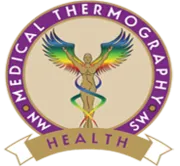What is Thermography?
This thermal imaging tool creates a digital map of your body that illustrates heat patterns -- patterns that may indicate some condition or abnormality. It uses a scanning-type infrared camera that measures your body surface temperature, presenting the information as a digitized image.
These thermal images (called thermograms) are analyzed for abnormalities that may be signs of disease in your body. Additionally, since your body is thermally symmetrical if normal, thermal asymmetries can indicate problems.
Additionally, thermograms provide:
- Reliable and accurate information for diagnosis, treatment, and prognosis...
- Precise and objective data from accurate measurements of thermal information...
- Considerable financial savings over conventional investigations...
And unlike most diagnostic tests, thermal imaging is:
- Not painful...Non-invasive...Quick – your multi-image exams usually take less than 15 -40 minutes. Makes no contact with your body -- with no body part compression (such as what you experience with mammograms)
- Emits absolutely NO radiation
Whether your pain is acute or chronic, thermography can help provide answers to your pain issue.
In fact, thermography:
- Remains the only method available for visualizing your pain and pathology...
- Can assess pain and pathology anywhere in your body....
- Is a very useful adjunctive procedure to other diagnostic tools, such as x-ray, bone scans, and ultrasound...
- Is very cost effective, risk free, and provides you with instant images...
- Fills in the gap in clinical diagnosis...
While x-rays, CT scans, ultrasound, and MRI scans are all tests of "anatomy" that measure structures of your body, thermography is unique in its ability to measure your physiological changes and metabolic processes.
What Else Can Thermography Help Monitor in Your Body?
Early thermal changes can be detected with thermography and is an area in which thermography excels. For instance, let's take heart disease prevention.

|

|

|

|

|
| Carotid Artery Inflammation | Severe Digestive Pain | Abdomen Inflammation | Food Allergies | Lower Back Dysfunction |
Thermography screenings can assess heart function and detect thermal changes in the carotid arteries (which may be a precursor to stroke and blood clots). When inflammation and/or occlusion of the carotid is visible, your doctor may do additional testing. Earlier detection of a heart problem may save your life.
And here are some other examples:
- Arthritis: Thermography can help you identify early signs of arthritis -- and differentiate between osteoarthritis and more severe forms like rheumatoid. Effective early treatment strategies can then be implemented, before you experience further degeneration.
- Neck and Back Pain: Thermal pain patterns ‘light up' white and red hot on a scan in the involved area. You can get relief faster and begin restorative care that more precisely targets the correct area.
- Dental Issues: If you have TMJ, gum disease, or an infected tooth, this will show up on a thermal scan as white or red hot.
- Sinus Issues & Headaches: Significant heat in your forehead or sinus region revealed on a thermal scan is an indicator that these systems in your body are not functioning properly.
- Immune Dysfunction, Fibromyalgia and Chronic Fatigue: The immune system correlates to the T1 and T2 areas of your spine -- high levels of heat in that region can indicate immune dysfunction. On the other hand, chronic fatigue, fibromyalgia, and aching joints are just a few complaints that correlate to cool patterns seen at this area.
- Carpal Tunnel Syndrome (CTS): This condition is often misdiagnosed. For instance, you may think you have CTS, yet the scan shows your neck is referring pain from a different affected area. This will help you get the most appropriate treatment.
- Digestive Disorders: Irritable bowel syndrome, diverticulitis and Crohn's disease are often visible with thermography. If you're able to address these conditions early on, you'll find that health restoration is much more likely.
- Other Conditions: Including bursitis, herniated discs, ligament or muscle tear, lupus, nerve problems, whiplash, stroke screening, cancer, and many, many others.
With all the great benefits of thermography, it may sound complicated -- but it's not!
Here are the simple steps you'll follow when you get a thermogram:
Step 1: You sit in a temperature-controlled room to allow your body to cool from any external conditions. At that time, you'll complete some simple paperwork, including a health survey.
Step 2: You're positioned in front of a Thermal Imaging Camera, dressed down in a robe and the technician takes digital pictures. You will be able to see yourself "live" on the computer screen, which can help give you a better understanding of your body.
Step 3: Your pictures are sent out to board certified MD physicians for analysis of 1) the amount of heat and 2) the symmetry of the heat patterns. Heat patterns may indicate inflammation, infection, or a variance from your body's normal temperature.
Step 4: You'll receive a report of findings in your mail shortly thereafter. This will help you and your doctor determine any next steps.
Step 5: We recommend you return for thermograms annually to monitor your health and watch for changes. Since everybody's body is different, the best way to identify problems is to measure changes from your own body's normal temperature.
